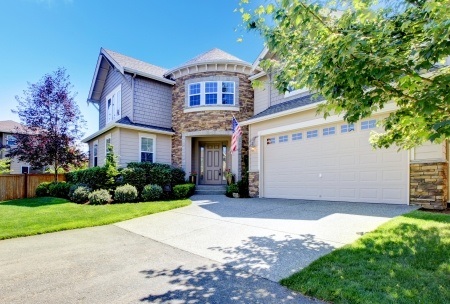Five Ways to Make Your Home’s ‘Curb Appeal’ Better Than Your Neighbors’
 Curb appeal, or how your home looks from the street, is an essential part of preparing to sell your house. It’s also where comparison with your neighbors’ homes is inescapable which poses a problem if you’re both on the market. Read on for five ways to boost your own curb appeal.
Curb appeal, or how your home looks from the street, is an essential part of preparing to sell your house. It’s also where comparison with your neighbors’ homes is inescapable which poses a problem if you’re both on the market. Read on for five ways to boost your own curb appeal.
Open Up: Garage Doors With Impact
In most homes, the external facade is taken up largely by the garage door which means it’s a big influence on how people see your home. Embrace that. Style your garage door to suit your home, touch up the paint or trim, or even do a full overhaul with a brand-new door.
Balance Out: The Appeal Of Symmetry
Not only is a symmetrical design visually appealing, it’s also quick and easy to do. If your home doesn’t allow for large symmetrical designs because of its structure — if it has a garage on one side, for example — focus in on specific elements. Consider the front door, maybe, where fixtures are easier and cheaper to update.
Sit Back: Inviting Outdoor Seating
A great way to attract buyers is to think like them and what search-weary buyer doesn’t enjoy a moment to relax? Arrange an aesthetically pleasing seating area outside your home. It will become a welcoming space that can offer buyers the chance to sit down and dream about owning your home. A clear and attractive walkway is also very inviting, so be sure to spruce yours up or install a whole new one to, literally, lead buyers to your door.
Admire The Art: Accent With Outdoor Pieces
Put a little of your home’s personality out front to attract the interest of like-minded buyers. Weather-resistant art pieces are a great way to accent your lawn or entrance. Consider the welcoming sound of wind chimes, or a sculpture or two. Even birdbaths can provide simple but effective artistic highlights.
Look Critically: Get Outside Eyes
When you’re close to your home, it can be hard to view it as a buyer would in other words, critically. This is an essential step, though, in creating effective curb appeal. So, consider getting another person involved. Someone who can look at your home objectively and provide a clear assessment of your home’s strengths and weaknesses.

 Delving into the real estate market for the first time can be a very intimidating thing with all of the mortgage and housing options available. Whether it’s market conditions or the amount you should be spending, there are a number of factors you’ll need to be aware of. If you’re just starting out and not sure where to begin, here are some points to consider that will set you on the right path.
Delving into the real estate market for the first time can be a very intimidating thing with all of the mortgage and housing options available. Whether it’s market conditions or the amount you should be spending, there are a number of factors you’ll need to be aware of. If you’re just starting out and not sure where to begin, here are some points to consider that will set you on the right path. Last week’s economic reports included readings on the National Association of Home Builders Housing Market Index, Commerce Department releases on Housing Starts and Building Permits issued and weekly reports on new jobless claims and mortgage rates.
Last week’s economic reports included readings on the National Association of Home Builders Housing Market Index, Commerce Department releases on Housing Starts and Building Permits issued and weekly reports on new jobless claims and mortgage rates.